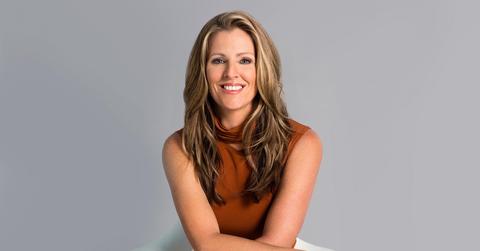
Kelly Tilghman Before TV
She would have been about eight years old, bouncing along in the passenger seat of the old Jeep next to her father and laughing as they bumped and rolled over dirt hills that soon would be fairways and through the rutted bowl of an empty lake that was yet to be filled. Phil and Kathryn Tilghman were building their golf course just off the highway in North Myrtle Beach, South Carolina, and though they couldn’t have known it at the time, both the course and the road were going to take their daughter far from home—further, in fact, than any of them might have imagined.
The oldest of five children and the only girl, Kelly Tilghman is today one of the most recognizable faces in golf. A Golf Channel star, the first female lead announcer for the PGA TOUR and a former pro golfer herself, she is also a businesswoman who’s navigated the predominantly male world of network television (with all of its inherent challenges), and she’s the mother of a four-year-old daughter to whom she’s absolutely committed. But before all of that, before the success in junior golf, the Duke scholarship, the pro tournaments in Europe and the rest of it, before Kelly could find her game, the family course had to get built.
“The suspension in the Cherokee Chief was terrible, but I was getting a big kick out of the bumps,” she remembers. “I watched [the course] come up from the ground up, from dirt to fairways. It was so impressionable for me as a kid.”
Gator Hole Golf Course was one of Rees Jones’ earliest designs and Tilghman says it provided the foundation for her success in the game. Additional credit, she says, goes to the fact that she grew up in a house on the third tee of Surf Golf & Beach Club, where her grandfather was a founding member.
“It was the perfect recipe for a little female golfer being born,” she says, “It was in the bloodline and in the business line; it was the perfect storm.”

Maine Jacket by REISS / Edie Dress from Project Gravitas / TRIIP Black shoes / Locus Cuff, Luna Ring, Composition Ring, by Lady Grey
Indeed, two of her relatives are in the South Carolina Hall of Fame as golfers: her grandfather Melvin Hemphill was a noted teaching pro who was coaching Jack Fleck when Fleck beat Ben Hogan in the 1955 U.S. Open at Olympic Club, and her great aunt Kathryn Hemphill was a dominant amateur who played on the 1938 Curtis Cup team with Patty Berg and Glenna Collett-Vare.
Kelly’s parents were accomplished as well: her charismatic mother Kathryn made a successful career in media sales and her father Phil was Mayor of North Myrtle Beach and a solid businessman. The two were also professional Shag dancers (her mother is in the dance’s National Hall of Fame), making for a full life with their full house.
A young Kelly didn’t dance—“I can do the basic shuffle step, and that’s where it ends”—but she was on board with her family’s legacy of achievement, even if the discipline preached by her father, a Citadel graduate and former Army captain, didn’t take, not at first anyway. Sports did, however, and especially golf.
-Golf was slow and terribly disciplined and very individual and lonely at times… And that really wasn’t me
“I didn’t like to practice,” she says. “My two best sports growing up were golf and basketball, though I played other sports. I loved basketball more because it was such a reactionary sport. I loved the team aspect, loved to sweat, loved everything about it. Golf was slow and terribly disciplined and very individual and lonely at times, and that really wasn’t me. I was more outgoing, and at the time I thought I was athletic and I didn’t think golf was tapping into that, wasn’t moving fast enough for me. But my father kept reminding me that this was where my real talent and my real future path lay, and I trusted him and continued to go to the course.”
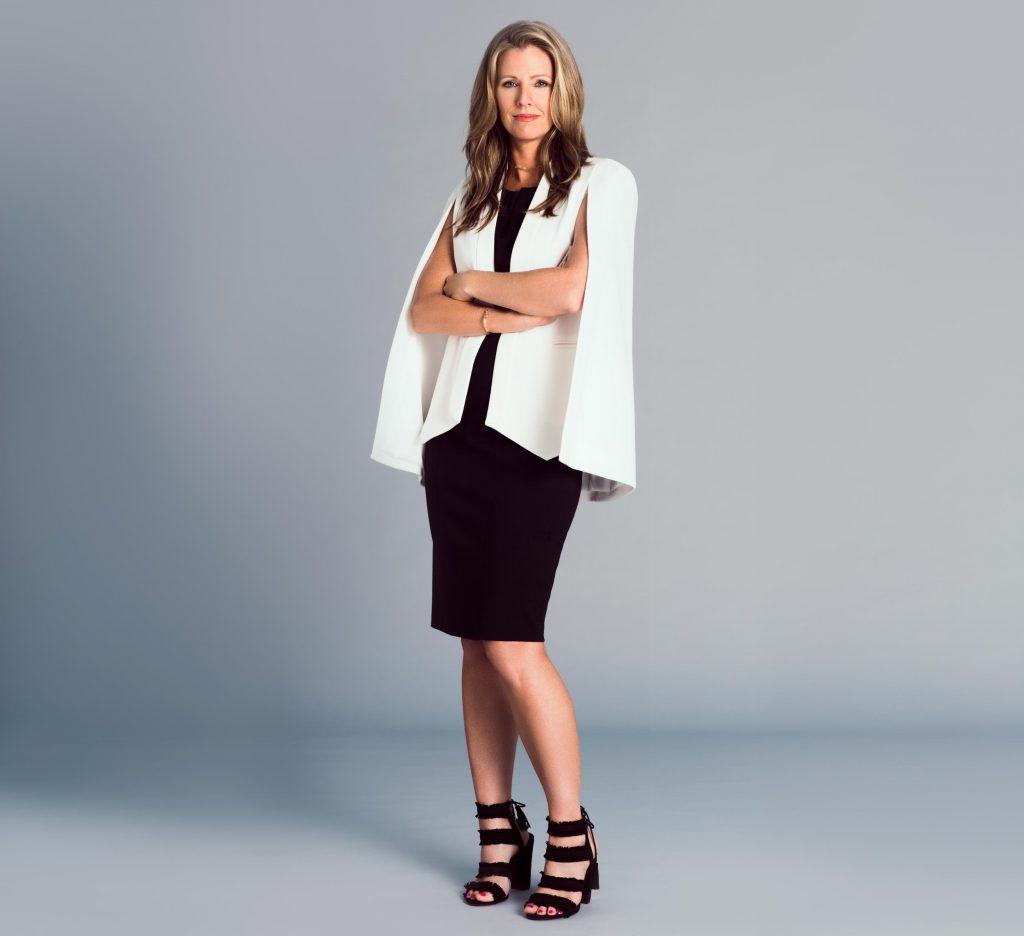
Finley Short Dress by Valentina Kova / Vincetta Navy trouser / Lady Grey Abalone Locus Pendant / Wwake ring / GUESS Econi sandal
Success in junior golf led to a partial scholarship offer at Duke University and full rides at other schools. For her father, it was one of the last teaching opportunities he would have before his daughter left home.
“He told me OK, you want to go to Duke. You can go for free to one of these other schools or you can help me pay for it. A lot of people are taken aback maybe by something like that, but I’m thrilled. He was teaching me a lesson: If I wanted it more, then I needed to kick it in more.”
And off to Duke she went, with that lesson in her back pocket. Tilghman says she found life in Durham to be incredibly liberating, if a little distracting.
“I’d sleep through classes, didn’t take it seriously. I was going to late-night frat parties… I had the freedom of dating whomever I wanted, whenever I wanted. I was open to the world, it was really neat. There were so many things that were new to me… I definitely drifted.
“I was quickly and easily distracted from golf, so much so that my college golf coach held up my scholarship papers in one hand and my report card in the other and said, ‘You gotta choose here. You’re not making good choices.’”
The conversation struck a nerve and Tilghman turned it around, buckled down and says she started making “dean’s list grades” from her sophomore year on. The hard work paid off on course as well. From 1988-1991 as a Blue Devil, she earned one victory, three top-20 finishes and a tie for 33rd place in the 1991 NCAAs, taking Duke to 13th place overall with the best score on her team. That particular tournament also saw her paired with a young phenom from the University of Arizona named Annika Sorenstam, who’s now a friend.
She graduated with a Bachelor of Arts in Political Science and History and set off to find herself, but she didn’t go looking on a golf course. Instead, she followed her college boyfriend to his hometown of Phoenix, where he was teaching at the lauded Brophy College Preparatory high school.
“When I graduated I’d had it with golf,” Tilghman says. “I realized I didn’t want to be that tour player my dad always wanted me to be. I was going to be a rebel, pursue this relationship and find whatever came my way. My dad accepted my decision and bought me the plane ticket to go out there and get started. He respected me making my own decisions.
“I tried to get a job with the telephone company. Tried to get a job at any office that would take me. This Duke education I had gotten, I was throwing it out the window.”
She ended up working as the assistant JV basketball coach and as a substitute teacher at Brophy’s sister school, Xavier College Prep, where pro golfers Grace Park, Cheyenne Woods, Heather Farr and Amanda Blumenherst went, in addition to actress Emma Stone and other notables.
“That didn’t last very long,” Tilghman says, “maybe a couple of months. Then I did the unthinkable: I resorted back to golf, because it’s all I knew.”
Kelly used a Duke connection to grab a job at McCormick Ranch Golf Club in Scottsdale, answering phones and booking tee times. It wasn’t uncommon for the likes of Phil Mickelson and other celebrities to come by McCormick, but Tilghman mostly golfed with some guys from a local community college.
“My boyfriend and I didn’t make it, and I started to date one of the guys. He and his friends, every time I would play, they would say, ‘You owe it to yourself to try and turn pro.’ I’d say, ‘That’s not what I want guys.’ I was way too young to understand what I needed to do.”
One day, bored with her job at the pro shop and pensive, Kelly says she was on a practice green in North Phoenix putting and contemplating her next move when a man came over and asked if she’d like to join his foursome. It turned out to be a life-changing moment.
-I thought, ‘I’m getting in way over my head here.’ He said, ‘Trust me, you’re going to make money today,’ And so I grabbed my clubs
“He told me what the stakes were: $20 skins and $10 closest to the pin. I thought, ‘I’m getting in way over my head here.’ He said, ‘Trust me, you’re going to make money today,’ and so I grabbed my clubs and headed over.”
The group included NBA legends and Hall of Famers David Robinson and Charles Barkley, who was in the driver’s seat of Kelly’s cart: “He said, ‘Throw those clubs on here young lady. You’re playing from the tips today, I don’t care who you are!’”
Nervous at first, the day could not have gone better for Tilghman, who didn’t hold back.
“I made $220 off Barkley,” she says, laughing. “He was so frustrated that he’d lost that day, that he jokingly balled up each $20 bill and threw it down! He threw them down in the parking lot and I had to pick them up—had to work for it! It was totally funny, he was being classic Charles. Then he gave me his number and said call me any time.”
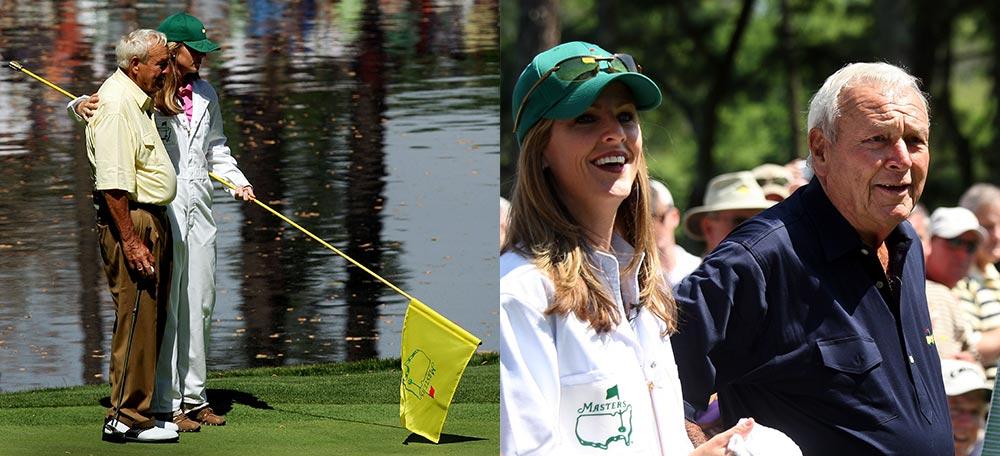
Caddying for Arnold Palmer at the Masters par-3 contest
The victory triggered something in Tilghman, who says that—following a great dinner with her boyfriend thanks to her winnings—she dug deep and decided that she was ready to attack the pro game.
“I was doing it for me this time, that was the beauty of it,” she says.
Two attempts to qualify for the LPGA at Q School didn’t work out and so she headed for tours in Europe, Asia and Australia, and the 1994 Women’s Australian Open in Royal Adelaide, which ultimately saw Sorenstam’s first professional victory.
“I was 24, 25, 26. I was doing it. I was doing it by myself, I was doing it for myself. I went out of my way, tried to pick up a couple of languages, tried to learn German, to improve my Spanish. I wanted to be one with the people, wanted to take it all in. That is when I feel I truly began to evolve as a woman.”
“Priority ‘A’ was to make the cut. Priority ‘B’ was, if you didn’t make the cut, head to all the historical sites, to the riverfront, get drunk while lying on a blanket and contemplate life with your best friend who also missed the cut. I had drinks at the top of what was then the highest hotel in Singapore, saw castles in Antwerp, waterskied on Lake Zurich, snow skied in the Swiss Alps on Cloisters, which is where I was told Lady Di and her family would frequent on occasion. I got drunk on the Thames, celebrated New Year’s between the Opera House and the Harbor Bridge in Sydney, just standing between the two. Took a gondola down a river in Bangkok, went to a snake farm, saw the Emerald Buddha, went scuba diving on the Great Barrier Reef, surfing in Brisbane, wine country in Adelaide. Once I got caught in a stampede of kangaroos while I was looking for my golf ball in Australia. You could feel the ground shaking… Playing, it was one of the most fulfilling times in my life.”
Fulfilling maybe, but not lucrative. Tilghman says she was one-for-five making cuts by the end of the Asian tour in 1996 and so she decided to hang it up. Again searching for a next move, Kelly once more turned away from the game.
“I decided to quit golf,” she says. “I’d played every day since I was 12. It was a hard decision, but I knew it was the right decision.”
For awhile, anyway. Perhaps inevitably, Tilghman eventually found herself on a range hitting balls and contemplating life. A man watched her for awhile, then came over and asked if she was a pro. She said she was done with that, he asked what came next, she said she didn’t have a clue, and he suggested broadcasting.
“He said, ‘you have what I consider to be an authoritative voice. I used to have a broadcasting firm in Palm Beach, let me give you my card. Maybe I can introduce you to somebody.’ You take everyone’s card, ‘Nice to meet you,’ and you walk off. But I kept that card and after a few days I decided to call him.”
The man made good on his offer of help, and after several months grabbing coffee and shadowing reporters at a Palm Beach station she had some TV experience under her belt and what she says was a horrible demo tape of her “broadcasting,” using bits of footage she shot when the reporters had finished their spots. However bad it was, she put it to work following a fortuitous encounter in Port St. Lucie.
“This man told me he worked for something called the Golf Channel and I was like, ‘What? Hold on: There’s a place that has television and golf?’”
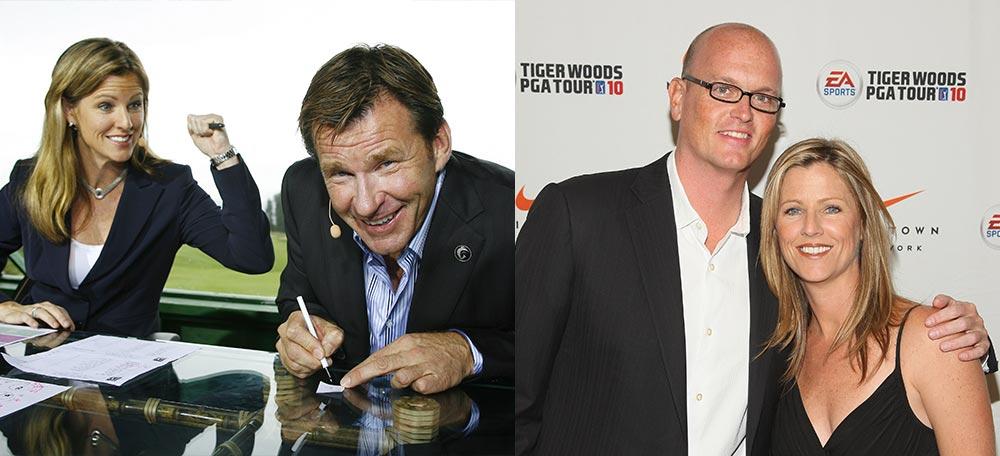
At work with Sir Nick Faldo: Right: With Scott Van Pelt
The man—Scott Van Pelt, now at ESPN—took Tilghman’s tape and off he went. Not long after, Golf Channel called and offered her a job working as a video librarian. From there it was production assistant, then graphics, then, finally, a shot at being on air. As the old saying goes, the rest is history.
At the time Kelly joined, she says Golf Channel had an audience of roughly 100,000. Today it’s available in more than 200 million homes in 84 countries and 11 languages across the globe.
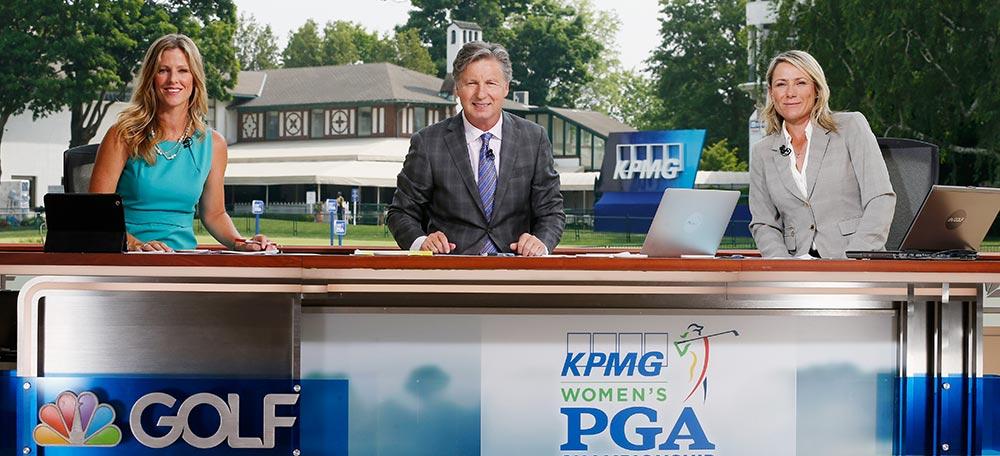
With Brandel Chamblee and Karen Stupples at the 2015 KPMG Women’s PGA Championship
Gator Hole Golf Course is now Gator Hole Plaza, complete with a Home Depot and other stores, and many of Tilghman’s relatives, including her father, eventually found their ways to the nearby highway and left town as well. But the family commitment to excellence remains as a legacy that Kelly is passing along to her daughter. Recently, she created more space in her life to do just that.
“I’ve taken a step back to pay more attention to my child, to be a better example. As it relates to living a life with exposure to limelight, I try to do two things: expose her to my positive experiences in television, so when I come home from work I might turn on a re-air of my show, let her see her mommy on TV. But I don’t bring her around the set or on shoots very much because I don’t want her to see people constantly coming up to her mother and giving me attention. I don’t want her to think that attention comes easy.
“I always say to my daughter, who’s only four-and-a-half—she’s frustrated easily—when she wants to quit something, I tell her it’s not a mistake if you learn from it, it’s not a failure if you tried. That’s what I say to my daughter all the time when she’s struggling with something. The mantra in my house is ‘I can do it.’ You can ask her, ‘What does your family always say?’ She’ll tell you: ‘I can do it.’ She utters it now by heart, I love it.
“We were at a park one day recently, she was trying to walk up the slide backwards like all kids do. She kept slipping at the steep part, slipping and slipping. I told her, what do we say in our family? She said ‘I can do it!’ Then she stood up, and she did it.”
This is an edited version of a longer article that appears in the spring 2017 issue of Women’s Golf Journal. To read the full version, purchase WGJ on the newsstand or subscribe here.
Credits
Photographer: Della Bass
Stylist: Karen Schijman
Makeup: Leslie Christin
Hair: Briana Chapman
Assistant: Kornell Samuels
